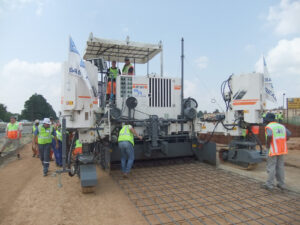The important role of concrete roads for a sustainable as well as resilient infrastructure was emphasised at the recent 14th International Symposium on Concrete Roads in Krakow, Poland, attended by Bryan Perrie, CEO of Cement & Concrete SA (CCSA).
A White Paper by the American Concrete Pavement Association (ACPA), “Concrete Pavements’ Role in a Sustainable, Resilient Future” was presented at the symposium to underline the issue. Perrie says concrete roads’ resilience is a particularly strong factor to consider by decision-makers for infrastructural development. “Sustainability deals with known events that can be quantified. Resilience, on the other hand, is the ability to anticipate, prepare for, and adapt to changing conditions and withstand, respond to, and recover rapidly after a disruptive event. In a changing global climate where extreme weather events are now becoming increasingly frequent, with far higher intensity than in the past, it is impossible to have a sustainable infrastructure without resilience. “Resilient systems limit the impact of relatively unexpected adverse effects such as storms, floods and droughts, such as experienced recently in KwaZulu-Natal and the Eastern Cape. The challenge is how to build more durable concrete structures while minimising the carbon emissions generated in producing and supplying cement and concrete,” he explains. Perrie says the SA cement Industry has already committed to Net Zero Carbon Emissions by 2050.
“It is critically important to address climate change and carbon reduction, but also essential to recognise that every road agency, province and municipality are facing budget constraints and often are forced to make decisions based purely on economic factors. Where LCCA is carried out, in areas where there is minimal data on concrete roads, the results are frequently heavily biased. The best way to improve the economic side of sustainability is to recognise the benefits of industry competition. According to the Massachusetts Institute of Technology (MIT) Concrete Sustainability Hub, US state agencies that have sustained a consistently competitive roads market – using both asphalt and concrete pavements over multiple years – pay lower prices for all paving materials. The States with the highest level of competition have unit prices that are 29% lower for concrete and 8% lower for asphalt.”
- Optimising pavement designs to ensure minimum quantities of materials;
- Reducing concrete’s carbon footprint by using extended cements appropriately; and
- Formulating concrete mix designs with optimised aggregate grading and optimised cement content.
- Fuel savings, particularly for heavy vehicles; and
- Increased albedo or reflectivity which minimises urban heat islands and can reduce required lighting at night.








